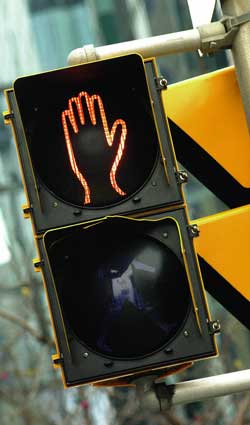 Pedestrians often misinterpret traffic laws when it comes to right-of-way.
Pedestrians often misinterpret traffic laws when it comes to right-of-way.
In Illinois, it is important to know that drivers AND pedestrians are both responsible for traffic safety. Northern Illinois University’s Department of Police and Public Safety advises caution for vehicles and pedestrians when approaching intersections and crosswalks.
According to the Rules of the Road, drivers must yield the right-of-way to a pedestrian:
- when a pedestrian is in a marked or unmarked crosswalk on the driver’s side of the roadway and there are no traffic control signals;
- when making a turn at any intersection;
- when making a lawful turn on a red light, after coming to a complete stop;
- after coming to a complete stop at a STOP sign or flashing red signal at an intersection;
- when a pedestrian enters a crosswalk before the traffic light has changed;
- when a pedestrian is walking with a green light, to a “walking person” symbol or a “walk” signal;
- when a pedestrian is leaving or entering a street or highway from an alley, building, private road or driveway;
- to persons working on highway construction or in a maintenance area; and
- to persons with disabilities.
“The markings of a crosswalk can give people a false sense of security that the lines will make motorists stop,” NIU Police Chief Thomas Phillips said. “You can’t just step out into the street without looking. The best advice is to be aware of your surroundings and obey the signals.”
The Illinois Pedestrian Law provides that when pedestrians do have the right-of-way, the pedestrian must exercise ordinary care for his or her own safety. What this means is that BOTH the pedestrian and driver must look out for each other so that accidents won’t happen. Their duties are equal and mutual.
With that in mind, here are some important safety tips for pedestrians, bicyclists and drivers using crosswalks around campus.
FOR PEDESTRIANS:
- Always cross at marked crosswalks.
- Obey any pedestrian signals and look left-right-left. By doing this you insure that the road is clear in both directions before crossing.
- If a vehicle approaches, make eye contact with the driver to be sure they see you before you cross.
- Look before walking past stopped vehicles. Do not cross just because a driver waves you on. Be sure all lanes are clear first.
- Remember that bicyclists are not considered pedestrians unless they are walking their bikes. Otherwise, they are considered vehicles.
- Yield to pedestrians.
- Remember that bicyclists are not considered pedestrians unless they are walking their bikes. Otherwise, they are considered vehicles and forfeit their rights as pedestrians in the case of an accident or citation.
- Obey vehicular traffic signals and laws on the roadways.
- Use extra caution as you transition between bike paths, roads and idewalks. Be aware that your actions are unpredictable to drivers and pedestrians.
FOR DRIVERS:
- Be alert for bicyclists and skateboarders, which move at faster speeds than pedestrians.
- Yield to pedestrians in the crosswalks and at intersections.
- Be prepared to stop at all marked crosswalks. Stay alert and reduce speed in areas with crosswalks.
- Come to a complete stop if pedestrians are crossing or preparing to cross.
- Wait until pedestrians have crossed at least one lane past the lane you are in before resuming travel.
- Never pass another vehicle that has stopped or is slowing down at a crosswalk.
Many pedestrians do other things while they’re walking such as texting, emailing, talking on the phone or listening to music despite that 70 percent consider those behaviors to be dangerous while walking in a crosswalk. Distracted pedestrians might have played a contributing factor in 4,200 pedestrian deaths and 70,000 injuries in traffic crashes in 2010, as reported by the National Highway Traffic Safety Administration.
“Be aware of your surroundings when walking, bicycling or driving,” Phillips said, “and always assume the ‘other guy’ doesn’t see you and isn’t going to stop.”

